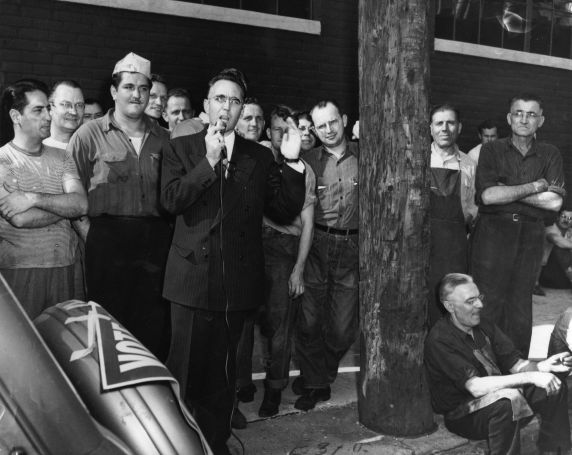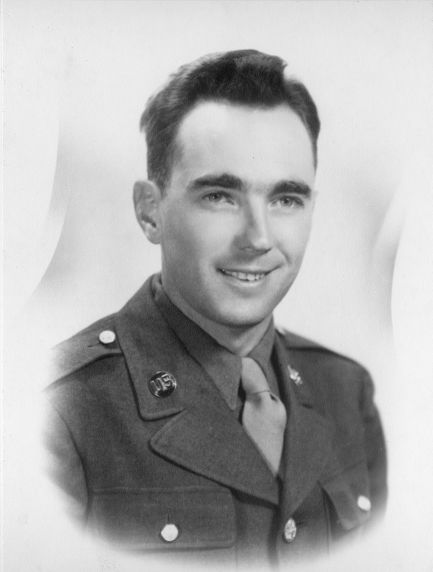Collection Spotlight: George C. Edwards, Jr. Papers
- Depressions--1929
- Detroit (Mich.)
- Detroit Housing Commission
- Edwards, George C. (George Clifton), 1914-1995
- International Union, United Automobile Workers of America (CIO). Local 174 (Detroit, Mich.)
- Jeffries, Edward, 1900-1950
- Student Blogger Series
- UAW
- Urban Affairs
- World War, 1939-1945
- World War, 1939-1945--Philippines
In the Winter 2012 semester, the Reuther Library worked with students in the Graduate Certificate in Archival Administration program at the Wayne State School of Library and Information Science to produce a series of student-written, guest blog posts.
Timothy McRoberts is a student at Wayne State's School of Information and Library Science.
George C. Edwards, Jr., had a major influence on the post World War II city of Detroit. Before the war, Mayor Edward Jeffries was serving a city that had just been through the Great Depression, and there were over 1.6 million residents that stressed the available housing stock. The automakers were not back to pre-Depression manufacturing capacity, and were losing major concessions to the United Auto Workers (UAW) on many labor-management issues (Capeci Jr., p.14). After 10 years of tough times, the city’s population did not have a rosy outlook on Detroit’s future. World War II changed all that. Jeffries's job became much more difficult as Detroit assumed the title of America’s Arsenal of Democracy. At its peak of efficiency, despite strikes and labor disagreements, Detroit’s industry output was $12 billion for 1943. An unprecedented increase in job-seeking migrants from all over America poured into Detroit. The sudden rise in population, primarily of African Americans, meant competition for living space and jobs with established Detroiters. As a result, in 1943, Jeffries found his city embroiled in the Riot of 1943 (Capeci Jr., p.15).
George C. Edwards, Jr. was born in Dallas, Texas in 1914. He came to Detroit via the East Coast in 1936 after working for Norman Thomas’s League for Industrial Democracy. His goal was to write a novel about Detroit’s autoworkers. Instead he found a job with Kelsey Wheel Company, joined the UAW, became an organizer, and was assigned to Walter P. Reuther’s Local 174 (Capeci Jr., p.12). His first brush with the law and labor strikes happened in 1937 when he defied a judge by refusing to apologize for his actions during the Yale & Towne Manufacturing Company’s sit down strike. He served 30 days in jail, and one year later was appointed to the UAW Welfare Department as director. This job brought him in close contact with Detroit city officials as he visited City Hall as part of his duties. Edwards met and became friends with Mayor Jeffries. They were dubbed the “odd couple,” Edwards being an outsider and little known, a liberal, and a union man. Jeffries was older, a moderate, and a publicly elected official, who “lived hard by night” (Capeci Jr., p.13). Jeffries understood that labor was a “permanent political force” that demanded representation in city government, and Edwards could help generate votes for him. Not only that, but the two men were good friends and could work together to serve the community (Capeci Jr., p.13). In 1940, Edwards became director of the Detroit Housing Commission when he was only 25 years old. In 1941, under Jeffries's tutelage, he ran for and won a seat on the Detroit Common Council; he was the youngest councilman elected at the time (Capeci Jr., p.13).
World War II was a pivotal point in the life of George C. Edwards, Jr. He was inducted into the army in January of 1944. His initial army training was set back when he injured himself playing football, and instead of going to Europe as an infantry replacement, he went to Officers Candidate Training School. After completion of Officers School, he expected to participate in the upcoming invasion of Japan, but fate intervened again when Japan surrendered soon after his arrival in the Philippine Islands. Having received his law degree from the Detroit College of Law in 1944, and having just passed the bar exam, he was appointed as an investigator for the War Crimes Division of the United States Army.
While overseas he was elected in absentia as president of the Detroit Common Council, a remarkable feat. He was able to do this by keeping in contact with his friends, campaign workers, and backers using an ingenious method. Edwards wrote “mimeographed missives” he called “Standard Operation Letters” or SOL’s (Capeci Jr., p.26). These would be distributed by his workers to other workers and family and friends. They were reprinted in office bulletins and the daily press. Edwards kept in contact with Mayor Jeffries through these SOL’s and personal letters. Edwards was able to organize his campaign from the Philippines, with the help of his wife Peg who organized his friends to get out the vote (Capeci Jr., p.27). It was through this series of letters and SOL’s to Jeffries that Edwards drew a picture of the life of a soldier, and in return Jeffries kept Edwards up to date with current news of Detroit and city politics.
This correspondence discussed the political, economic, and social aspects of Detroit during World War II. Edwards informed Jeffries about the life of a soldier during training, and of an officer living and working as an investigator for the army in the Philippines (Capeci Jr., 224). While stationed in Manila, his job was to prepare evidence against those responsible for atrocities committed at the Los Banos Internment Camp. It was reported that chief warrant officer Lieutenant Sadaaki Konishi of the Imperial Army, the man who commanded the camp had died. After finding out he was still alive, Edwards headed the investigation that lead to his capture.
Edwards played an important role after returning to postwar Detroit. Although he lost to Albert Cobo during the 1949 Detroit Mayoral election, during the 1950s he was appointed to the Wayne County Juvenile Court, the state circuit court, and the state supreme court (Capeci Jr., p. 34). He became Detroit’s Police commissioner in 1962. In 1963, he accepted a seat on the United States Sixth Circuit Court and became its chief judge during the 1970s and a senior judge in the 1980s. He died in 1995.
The George C. Edwards, Jr. Papers, Parts 1-4 reveal much about the man's life and career. Correspondence from his time in World War II is included, as well as newspaper clippings and a great deal of additional material related to his career in public service to the city of Detroit.
References
Capeci Jr. Dominic J. (Ed.). (1996). Detroit and the “good war”: The world war II letters of mayor Edward Jeffries and friends. Lexington, Kentucky: The University Press of Kentucky.
- Public Relations Team's blog
- Login to post comments
- Printer-friendly version



 Reddit
Reddit Facebook
Facebook LinkedIn
LinkedIn